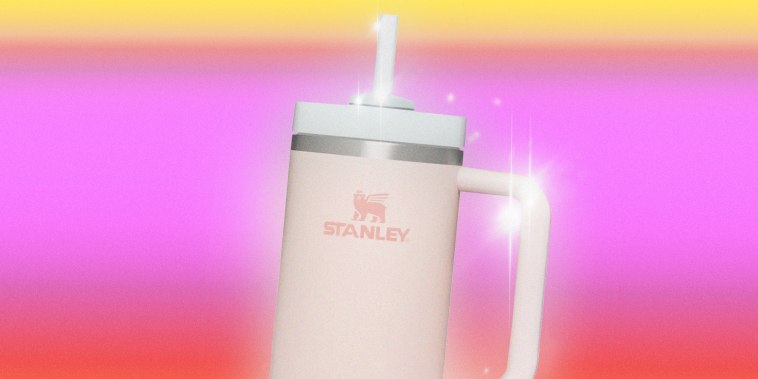
A stainless steel cup is proving surprisingly durable in the often erratic world of internet fads.
It’s called the Stanley “Quencher,” and it checks in at 1 foot tall. Capable of holding 40 ounces of liquid, it’s been described as an “emotional support” water bottle by some, and a must-have by others.
And although it first caught on as a trendy object during the pandemic, the cup has proved to be a surprisingly resilient cultural object, joining Pumpkin Spice Lattes and Ugg boots among the long-lasting hallmarks of Gen Z/millennial girl culture.
Stanley, a company that had once been best known for making thermoses favored by blue-collar workers and campers, has stayed a favorite among younger people, topping many holiday wish lists.
The hashtag #StanleyCup has amassed over 6.8 billion views on TikTok. According to figures shared with CNBC, Stanley’s annual sales for 2023 are projected to top $750 million.
This week, the popularity of its cups reached new levels after the release of a special edition “Winter Pink” cup, sold exclusively at Target, spawned a frenzy online and people crowded stores across the U.S. in hopes of securing just one of the coveted tumblers.
Vincent Marcus, an influencer based in Los Angeles, was among the thousands who trekked to Target to get the limited edition drinking vessel for his 10-year-old daughter, who heard about the release on social media.
“She and her friends are really realizing the hype,” he said, noting his daughter had four cups already. “The desire to collect is only a recent thing.”
Armed with folding chairs, they arrived at a local Target at 1 a.m., waiting in 40-degree weather for the 8 a.m. opening of the store’s doors. In a video posted to TikTok, Marcus showed a line snaking around the block behind them as the night progressed.
Once inside, Marcus said the store’s manager started counting people. Only the first 40 were able to secure the coveted item.
“I fully recognize that it was an insane thing to do, but it was all for her,” he said. “Of course, it’s just a cup.”
However, Marcus said his daughter and others have been drawn to the fact that the cups “have a collectability factor.”
The wait was worth it: After the cup was successfully obtained, he said his daughter “carried it around the entire day afterwards.”
Other Stanley enthusiasts online said they witnessed physical altercations and general chaos amid high demand for the collaboration.
The limited edition cup is already listed on resale sites for up to $300.
Thousands of people have joined a handful of popular Facebook groups dedicated to hunting down various cups and buying, selling and trading them. Its popularity has even inspired a toy, which one Instagram account called trendyfavefinds described as “a baby ‘Stanley.’”
There was a moment in time where it seemed like the Stanley cup brand could have been cast aside. But a consumer — Ashlee LeSueur, a Salt Lake City native and lifestyle blogger — stepped in to help.
LeSueur, who had purchased her first Quencher in 2017, began gifting it to friends and recommending it to followers on her blog, The Buy Guide, according to CNBC.
When the Quencher was on the brink of being discontinued in 2019, she lobbied to save her favorite cup and bought 5,000 Quenchers at wholesale price.
In 2020, after Stanley brought on Crocs veteran Terence Reilly as its new president, he partnered with The Buy Guide. The brand launched a collaboration with the blog to promote new collectible colors such as Desert Sage and Cream.
“My experience at Crocs was fueled by collaboration culture and drop culture,” Reilly told CNBC. “And I knew that once we had our legs under us at Stanley, and once we could see the connection to consumers that we were creating, we were also ready for collaborations.”
The Quencher became Stanley’s top-selling product that year, and has retained that spot ever since.
While it may come as a surprise to see a water bottle hold such a beloved spot in consumer hearts, brand loyalty for similar products is not unprecedented.
The Hydro Flask was also once considered the go-to water bottle accessory of the day, having usurped the Nalgene before it as the “it girl” hydration product. It gained popularity during the 2010s for its ability to keep the ice in water cold for 24 hours and came in a variety of vibrant colors. But consumers said it had a flaw — it didn’t fit in the cupholder of a car.
Even amid the rise of Stanley cups, some Gen Z social media users have already shifted their attention toward another water bottle company — the Owala.
One TikTok user analyzed water bottle trends over the years, predicting a year ago that Owala water bottles would eventually become the next big thing.
“When you see Owalas everywhere, I’m telling you, come back to me,” the creator said in the video. “Follow the people who are nurses. They are on the water bottle trends first.”
Another user posted a video silently comparing the two insulated water bottles — when she flipped both the Stanley Cup and Owala upside down, the Stanley cup appears to leak a puddle of water onto the floor.
Some comments on videos comparing the two brands characterize Owala as the “cooler younger sister” to the Stanley cup, which has been designated by some users as “basic.”
“Just trying to keep up with Gen Z,” one TikTok user said, while showing off her new Owala in a video.
